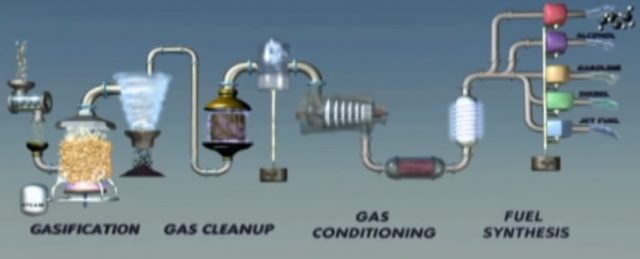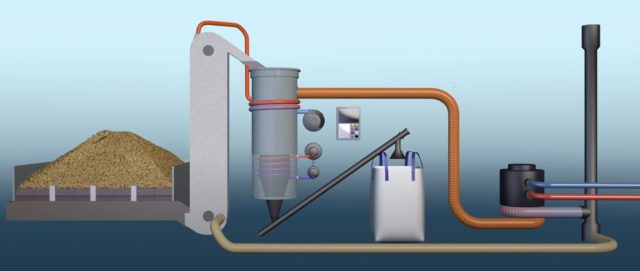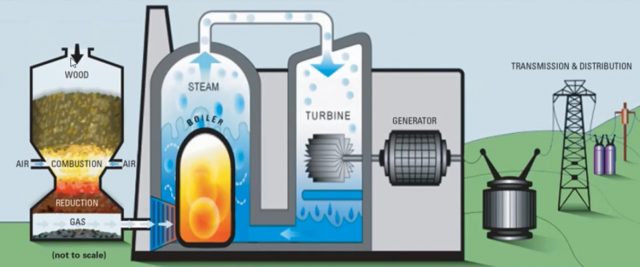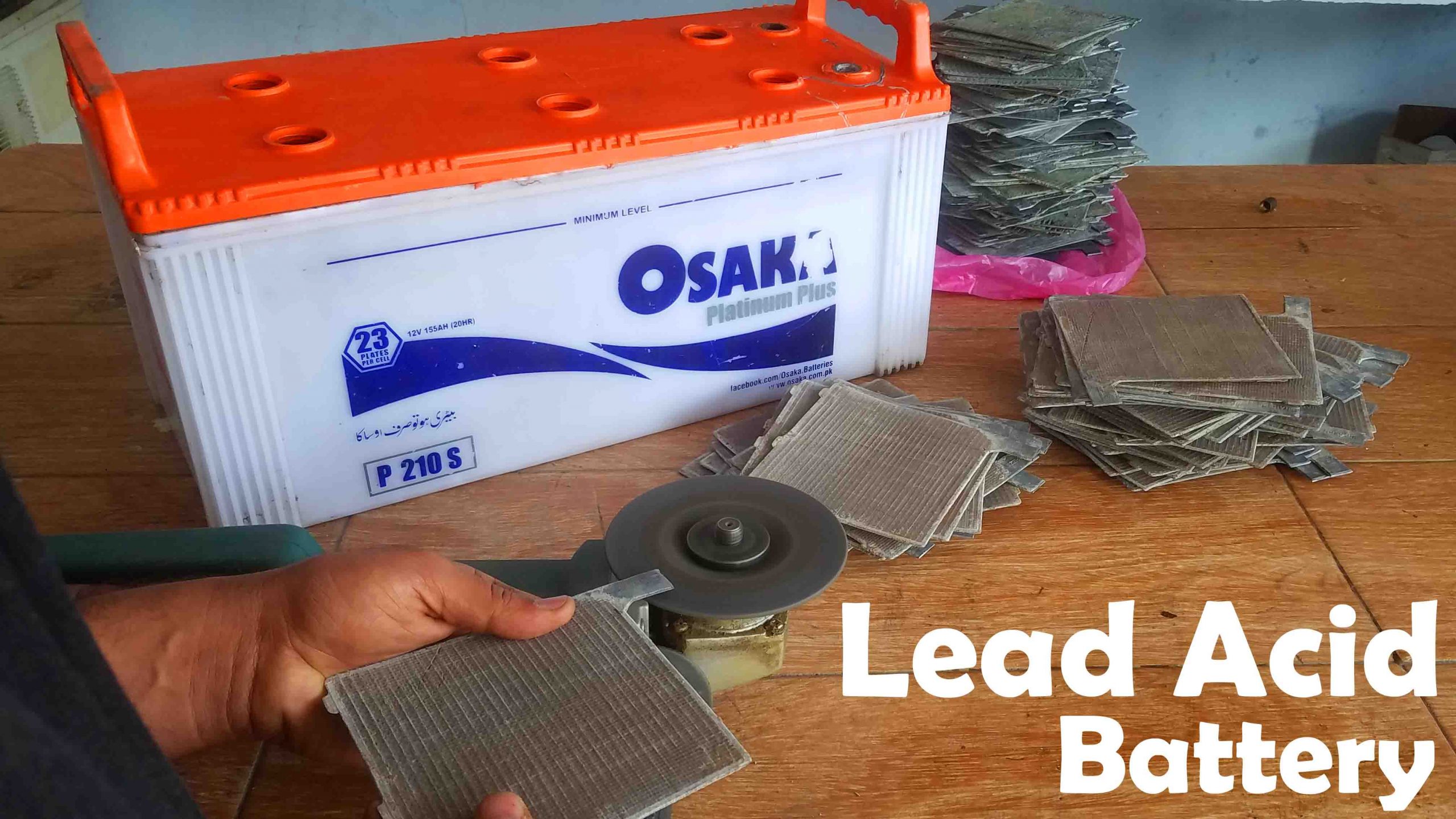Biogas Power Plant, Biomass Power Plant, Biomass Electricity
Table of Contents
Biogas power plant:
Biogas Power Plant- Biomass or bio energy refers to energy produced from the organic matters. Biomass is defined as living matter or its residue which is renewable energy source. Common examples of biomass are grass, wood, herbs, trees, animals, agriculture and forestry residue. Chemically speaking biomass refers to hydrocarbon contain carbon, hydrogen and oxygen. Biomass is a gaseous mixture which contains stored energy this energy is generally composed of 40 % of carbon dioxide, 60 % methane (a high value fuel) and traces of other gases such as hydrogen sulphide and nitrogen. Biomass is primarily found in the form of living or recently living plants as well as waste. Biomass is cheap source of energy. The term feed stock is used to refer whatever type of organic material will be used to produce energy. Different feed stocks will have different physical composition but generally all feed stocks have includes varying amounts of carbon, water and organic volatiles for energy production. A feed stock must be converted using one of many processes. Some common biomass conversion processes include combustion the process where the feedstock is burn in the presence of air to release heat. Combustion can be used to heat steam for electricity generation as well as gasification.
Biogas Power Plant produces a gas that can be used to electrical thermal energy on account of its high percentage of methane. Biogas is generally produced from cattle dung in a biogas plant, known as gobar gas plant, through process called digestion that involves anaerobic fermentation. The raw material used in bio gas plants also known as substrates are of liquid manure agriculture products. Biogas is manufactured by using biomass as raw material. It is estimated that biomass contributes about 15 % of the world total energy requirement.
According to a new report from Navigant Research global installed bio power capacity will grow gradually over the reminder of the decade from 58.6 giga watt (GW) in 2013 to 82 GW in 2020.
Scope of Biomass in Pakistan:
Pakistan is basically agriculture where mostly people occupation is agriculture and it contributes about 60% of the country economy. Agriculture waste and animal is available in surplus in all parts of the country, so we have huge chunk of agriculture waste and which can be converted into biofuel. Urban areas of Pakistan generate over 55000 tons of solid waste daily. Secondly we have a huge chunk of livestock available. It is estimated that about 21.35 million biogas can be generated by using animal dung. So Pakistan has potential to produce electricity.
If we see the overall status of the energy generation biomass produces almost 12% of electricity or energy and 88% from the non-biomass. In 12% of the biomass 6.9% from traditional biomass and 5.1% from modern biomass energy. It is huge value compared to other renewable sources and if we compare the overall growth of the biomass that it produce 591 terawatt hour of electricity from biomass.
Production of Biomass energy:
In the biogas production process we put the biomass in the container and with water with some chemicals and after certain time it will produce gas known as biogas. The Biogas Power Plant uses renewable raw materials such as in silage as maize with the aid of a wheel loader. The maize is tipped in to a storage bin which leaves filling up approximately once day silo maize is rich in energy in and on account of its high degree of reduction very well suited for use in Biogas Power Plant. This bin is equipped with a hydraulic floor discharger that continuously feeds the maize on to a conveyor belt. A scale under the conveyor belt registers the weight of the maize. After short interim storage in the big size it is pumped through the pipes directly in to the blending pump beside the maize conveyor belt at the same time the maize falls off the conveyor belt in to the separator which is equipped with two mixing rollers. In this way the maize silage is mixed before fermentation. With this technology it is possible to supply several fermentation tanks also known as fermentis with fresh substrates even if they are not close together. Liquid waste from the food industry is the substrate used in this plant as the availability of the wastes varies considerably a large storage pit should be installed integrating this in to a hall serves to minimize smells and to help prevent epidemics. Then liquid waste is heated with hot water 270 degree centigrade in a tubular heat exchanger using a counter current process. After heating for one are the hydrogenation of the substrates is complete so they can now also be poured in to the fermentis. When the bio gas is formed the substrates are continuously stirred in order to prevent the layers of material forming at the top or bottom. A hot water wall heater hits the substrate to between 35 and 55 degree centigrade in order to accelerate the formation of methane on the average the substrate is in the fermenter for a period of around 30 days before. It is filled in to another fermenter for a further 30 days to complete the gas formation process.
Now to understand that how the biomass get energy we know that know that plant absorbs sunlight energy in the process of photosynthesis. Plants store this energy in various parts; this store energy is known as the chemical energy. Wood, crops, vegetables contain chemical energy. The basic process to produce heat or electricity from the biomass we have difference kinds of sources available such as agriculture waste, animal manure, forestry waste, industrial waste, municipal waste, sewage sludge, crops and lingo cellulose feedstock these are basically the solid waste through which heat is produced by the combustion and this heat will produce steam. Then this heat is used for the power generation. There are several methods with the help of which we can generate energy:
Gasification:
The second process is gasification in which we mix the solid waste and water with some chemicals which will produce carbon dioxide, carbon monoxide and hydrogen gas etc. This will be used for the production of methanol which will be a bio fuel.
The thermochemical process uses heat to break down biomass into the intermediates such as bio oil that can be upgraded into fuel and other products. In the gasification process biomass turns into hydrogen and carbon mono oxide rich gas called synthesis gas or syngas which is then converted into liquid transportation fuels or other products. Gasification occurs relatively at high temperature.
Wood material such as forest residue is a common feedstock for the gasification process. For the best result the feed stock wood chips are no more than two inches in size and have 20 to 30 % moisture content by weight depending on the gasifier.
Gasifier:
In the gasifier the biomass is broken down into the vapour in a carefully controlled environment that typically contains oxygen or steam. The syngas produced made up of carbon monoxide and hydrogen. Char is solid bio product of gasification, is typically removed using a cyclone.
Cyclone:
Cyclonic separation allows removal of particulates from a gas stream without a filter, by using rotation effects in combination with gravity to collect the particles. Tars and methane is also produced their quantity and composition depend upon the gasification environment. Tars are high molecular weight organic compounds. If they are not removed these tars will contaminate downstream equipment and inhibit fuel synthesis. One way to remove methane and tars by using special catalyst to convert the compounds into additional syngas thus eliminating the methane and tar problem while also improving the efficiency of the process.
Additional cleaning and conditioning steps may be require to remove other contaminates such as ammonia, sulphur and carbon dioxide. The syngas is then conditioned to produce the desired ratio of the carbon monoxide and hydrogen to achieve optimal chemical reactions in subsequent steps. The pressurized hot syngas is then passed over catalyst to form a liquid. The catalyst is contained in a reactor and the syngas is passed through the reactor where the carbon monoxide and hydrogen molecules combine to form larger molecules. These molecules are subsequently cooled, condensed and refined into clean transportation fuels and other products.
Pyrolysis:
Similarly by the process of pyrolysis bio fuel is produce from solid waste and after FT conversion it will be converted into biodiesel which will be used for the production of energy. Biomass storage and drying contains wooden or agriculture biomass stored in a dedicated storage facility is transported to the pyrolysis reactor via a bucket feeder. The raw biomass is pre-dried inside the feeder through the use of hot and dry air flowing in the cross flow. Biomass has pre-drying has a positive impact on the reduction of the moisture contents inside the process material by a few per cent and additionally increase the pace of the process occurring in the following stages. The pre-dried and pre-heated biomass goes to the pyrolysis reactor where the following process takes place.
-
Evaporation
All the moisture accumulated in the raw biomass has to evaporate in order to initiate the carbonisation process depending on the type of biomass and the amount of moisture accumulated in the process material and its efficiency is due to high temperature in the upper part of the reactor.
-
Degasification process
In the degasification process the biomass is degasified in the temperature range of 370 to 400 degree centigrade within which range the removal of volatile particle is most efficient chemical compounds like nitrogen, carbon monoxide, carbon dioxide, hydrogen and other are flammable an approximately 40% of the energy yield is consumed by the pyrolysis process. After mixing with humid air from the proceeding process, the reminder of these gases can be used for energy.
-
Carbonization process:
In the carbonization process the dried and degasified biomass is treated with high temperature. This process results in the quick concentration of the elemental carbon and the disappearance the fibrous structure and improving its grind ability depending upon the temperature insides the reactor and duration of the carbonization process the ready material can have calorific value in the range of 21 to 29 mega joules per kilogram.
-
Cooling process:
In the cooling process the ready material is cooled to ambient temperature with the use of cross flow water.
In the next stage the carbonized biomass is loaded to big bags palletized or transfers directly to the boiler where heat generation occurs. The flammable gases has relatively low calorific value so the best way to use it by conversion to hot water. Pyrolysis process has productivity from 300 to 1000 kilogram per hour can supply heating networks with maximum capacity from 1 to 3 megawatt respectively. The yield of the flammable gases depends on the type and quality of the biomass and the expected characteristics of the carbonized biomass. In order to maximize the efficiency of the pyrolysis process hot air taken from the coat of the reactor is used in the biomass pre drying process. Hot air is transferred to the bucket feeder which has illustrated some time ago. At the end of the process all the gases are emitted and mixed through the common stack.
Extraction:
There are some crops which are basically oil crops and after the extraction we used esterification process which will convert the crop oil into biodiesel.
Fermentation:
We also have some sugar crops through the fermentation and distillation process the ethanol is produce. In this we convert biomass in to some useful gases with the help of bacterial actions. In brazil ethanol is used as bio fuel.
Anaerobic digestion:
The wap biomass is after the anaerobic digestion produce bio gas through which hydrogen gas will be produce which will be used for the production of heat.
Production of electricity:
We have solid waste which will be used for the production of the heat. By burning the solid waste heat will produce which will be used for the heating of water in order to produce steam.
This steam which has about 500° C temperature called dry steam. This steam is injected to the turbine and due to the pressure of the steam the turbine will start rotation which is connected with generator which produces electricity.
Advantages of Biomass:
- Biomass is always and widely available as a renewable source of energy which can be used again and again.
- It is carbon neutral which means that it will produce very less amount of carbon dioxide compare to other sources like natural gas, coal. Due to which it is environmental friendly. It does not produce nitrogen dioxide and sulphur dioxide.
- It reduces the overreliance of the fossil fuels because it is the substitute fuel available to produce heat and electricity.
- It is less expensive than fossil fuels and requires less investment.
- Biomass production adds a revenue source for manufactures because almost every country produces biomass.
- Less garbage in landfills.
- It is available throughout the year.
- It is alternate form of energy.
The world’s largest biomass plants:
Among the nations that utilize biomass incorporate nations, for example, United Kingdom and the Nordic nations of Europe, for example, Poland and Finland, being this last one which all the more regularly shows up in the main 5 of biomass plants. Finland has 3 of 5 of the world’s biggest biomass plants. What may this be?
Since 2008 the cost of solar panels in Finland has dove, they have gotten less expensive by 80% and its efficiency has been expanding. The new solar panels will work on rainy and dim days, and the efficiency of the solar panels increments at low temperature and in clean and residue free conditions.
Another motivation behind why Finland drives the ranking of the world’s five biggest biomass plants is on the grounds that the nation was until a couple of years back vivaciously reliant on different countries. Since 2010, Finland’s energy independence has been looked for, zeroing in on sustainable power sources. Constantly 2050 it is anticipated that the energy created in the country is 100% of inexhaustible beginning.
As we have seen previously, different countries go with Finland in the ranking of the world’s biggest biomass plants, for example, the United Kingdom and Poland. How about we perceive how they are positioned:
1-IRONBRIDGE (UNITED KINGDOM)
It is the biggest unadulterated biomass plant on the planet. It is situated in SevernGorge, UK, and has a capacity of 740 MW. The 1,000 MW facilities of a previous coal-fired power plant were changed over in 2013 for biomass power generation. The fuel utilized in this biomass plant is wood pellets.
2-ALHOLMENSKRAFT (FINLAND)
This 265 MW plant is situated at the UPM-Kymmene paper plant facility in Alholmen, Jakobstad, Finland. It has been in operation since the start of 2002. It likewise supplies 100 MW of warmth to the paper factory and 60 MW of district heating for the residents of Jakobstad. The plant utilizes a circling fluidized bed boiler.
3-TOPPILA (FINLAND)
This biomass power plant is situated in the Toppila district of Oulu, Finland. It is perhaps the biggest plant on the planet that utilizes peat as a fuel and has a capacity of 210 MW of electrical energy and 340 MW of thermal power. It has two units of 75 MWe and 145 MWe.
4-POLANIEC (POLAND)
It has an installed capacity of 205 MW. It is situated in Staszów and is the fourth biggest biomass plant on the planet. It entered commercial operation in November 2012 and for the most part utilizes agricultural by-products and wood residues for its operation. The facilities produce enough electricity to meet the needs of 600,000 family units, lessening 1.2 million tons of CO2 outflows every year.
5-KYMIJARVI (FINLAND)
It has 160 MW and is situated in the city of Lathi, around 100 km north of Helsinki. They are gasification based installations that utilization recuperated solid fuels, for example, plastic, paper, cardboard and wood. This biomass Power plant began its commercial operation in 2012, incorporating a gasifier that changes over the fuel got from squander into ignitable gas. It incorporates a characteristic dissemination steam boiler, a Siemens SST 800 Tandem turbine and a Siemens Gen5-100A-2P generator. It creates 300 GWh of electricity and 600 GWh of district heating. It transmits electricity to the National Grid utilizing a 110 kV connection at the Kymijärvi substation.





